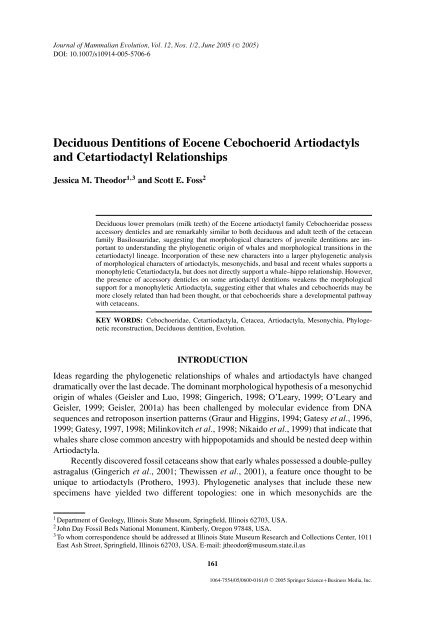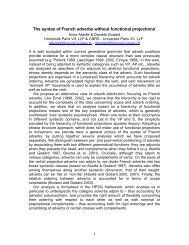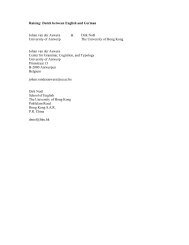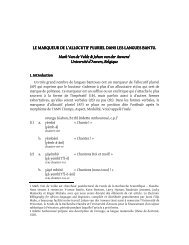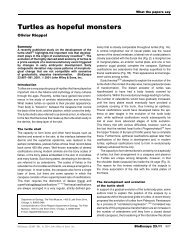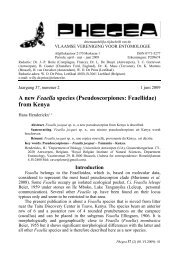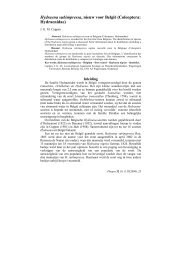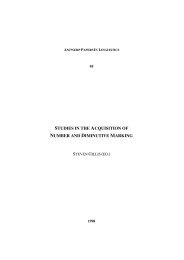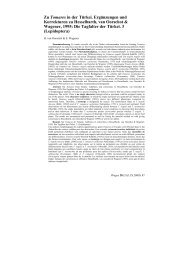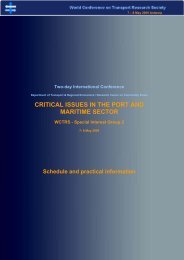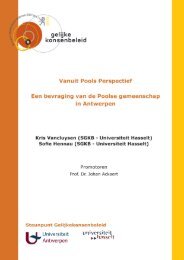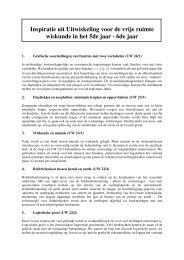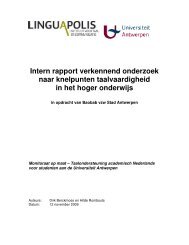Theodor2005.pdf
Theodor2005.pdf
Theodor2005.pdf
You also want an ePaper? Increase the reach of your titles
YUMPU automatically turns print PDFs into web optimized ePapers that Google loves.
Journal of Mammalian Evolution, Vol. 12, Nos. 1/2, June 2005 ( C○ 2005)<br />
DOI: 10.1007/s10914-005-5706-6<br />
Deciduous Dentitions of Eocene Cebochoerid Artiodactyls<br />
and Cetartiodactyl Relationships<br />
Jessica M. Theodor 1,3 and Scott E. Foss 2<br />
Deciduous lower premolars (milk teeth) of the Eocene artiodactyl family Cebochoeridae possess<br />
accessory denticles and are remarkably similar to both deciduous and adult teeth of the cetacean<br />
family Basilosauridae, suggesting that morphological characters of juvenile dentitions are important<br />
to understanding the phylogenetic origin of whales and morphological transitions in the<br />
cetartiodactyl lineage. Incorporation of these new characters into a larger phylogenetic analysis<br />
of morphological characters of artiodactyls, mesonychids, and basal and recent whales supports a<br />
monophyletic Cetartiodactyla, but does not directly support a whale–hippo relationship. However,<br />
the presence of accessory denticles on some artiodactyl dentitions weakens the morphological<br />
support for a monophyletic Artiodactyla, suggesting either that whales and cebochoerids may be<br />
more closely related than had been thought, or that cebochoerids share a developmental pathway<br />
with cetaceans.<br />
KEY WORDS: Cebochoeridae, Cetartiodactyla, Cetacea, Artiodactyla, Mesonychia, Phylogenetic<br />
reconstruction, Deciduous dentition, Evolution.<br />
INTRODUCTION<br />
Ideas regarding the phylogenetic relationships of whales and artiodactyls have changed<br />
dramatically over the last decade. The dominant morphological hypothesis of a mesonychid<br />
origin of whales (Geisler and Luo, 1998; Gingerich, 1998; O’Leary, 1999; O’Leary and<br />
Geisler, 1999; Geisler, 2001a) has been challenged by molecular evidence from DNA<br />
sequences and retroposon insertion patterns (Graur and Higgins, 1994; Gatesy et al., 1996,<br />
1999; Gatesy, 1997, 1998; Milinkovitch et al., 1998; Nikaido et al., 1999) that indicate that<br />
whales share close common ancestry with hippopotamids and should be nested deep within<br />
Artiodactyla.<br />
Recently discovered fossil cetaceans show that early whales possessed a double-pulley<br />
astragalus (Gingerich et al., 2001; Thewissen et al., 2001), a feature once thought to be<br />
unique to artiodactyls (Prothero, 1993). Phylogenetic analyses that include these new<br />
specimens have yielded two different topologies: one in which mesonychids are the<br />
1 Department of Geology, Illinois State Museum, Springfield, Illinois 62703, USA.<br />
2 John Day Fossil Beds National Monument, Kimberly, Oregon 97848, USA.<br />
3 To whom correspondence should be addressed at Illinois State Museum Research and Collections Center, 1011<br />
East Ash Street, Springfield, Illinois 62703, USA. E-mail: jtheodor@museum.state.il.us<br />
161<br />
1064-7554/05/0600-0161/0 C○ 2005 Springer Science+Business Media, Inc.
162 Theodor and Foss<br />
sister-group to a monophyletic Artiodactyla + Cetacea (Cetartiodactyla) (Thewissen et al.,<br />
2001); and one in which mesonychids are the sister-taxon to a paraphyletic Artiodactyla.<br />
In the latter topology, Cetacea is nested within the Artiodactyla as the sister-taxon to the<br />
extant hippopotamids (Geisler and Uhen, 2003). The new fossils have refuted a sister-taxon<br />
relationship between whales and mesonychids, and affirmed a strong relationship between<br />
whales and artiodactyls, but have not provided strong support for a whale–hippo relationship.<br />
This is not surprising, given that early whales and all artiodactyls share the character of<br />
the double-trochleated astragalus, and the new specimens do not seem to provide character<br />
evidence uniquely linking whales and hippos to the exclusion of other artiodactyls.<br />
Morphological suites of characters that support the placement of whales within<br />
Artiodactyla have been difficult to find because the phylogenetic relationships within early<br />
Artiodactyla are poorly resolved (Gentry and Hooker, 1988; Scott and Janis, 1993; Stucky,<br />
1998; Geisler, 2001b) and relevant taxa are poorly represented in many phylogenetic studies.<br />
Aside from Luckett and Hong’s (1998) work on the 6-cusped dp4, little attention has<br />
been paid to other characters of the deciduous teeth in phylogeny reconstructions.<br />
Deciduous dentitions from several genera belonging to the Eocene European artiodactyl<br />
family Cebochoeridae have second and third deciduous premolars (dp2–3) that<br />
possess accessory denticles and resemble the deciduous and adult teeth of derived archaeocete<br />
whales. These teeth do not resemble the adult cebochoerid premolars or any other<br />
artiodactyl dentition (adult or juvenile) we examined. This similarity between cebochoerid<br />
artiodactyls and archaeocete whales has not previously been noted; presumably because<br />
deciduous teeth are seldom preserved, and the resemblances are obscured by wear in most<br />
fossilized deciduous teeth. Among the specimens examined, one particular specimen of<br />
Cebochoerus lautricensis, from the Aquitanian Basin, France, MNHN.EBA 327 (Fig. 1),<br />
has relatively unworn juvenile teeth and displays the unusual morphology also found in<br />
more heavily worn specimens of cebochoerid subadults (Fig. 2(c–f)). The discovery of this<br />
specimen led us to review the deciduous dentition of cebochoerids in more detail, and to<br />
test whether the similarities in the juvenile lower premolars of cebochoerids to archaeocete<br />
teeth represented a synapomorphy or convergence.<br />
MATERIALS AND METHODS<br />
We describe below the deciduous dentitions of the cebochoerid genera Cebochoerus<br />
and Acotherulum, based on the following specimens:<br />
Acotherulum sp.: MNHN.Qu7075, right maxilla with dP2-4, M1-2 (Fig. 3(b));<br />
Qu7076, right dentary with dp3-m2 (Fig. 3(c and d)); Qu98, anterior mandible with fused<br />
symphysis, alveoli for dp1-2, dp3-m1 present; Qu88, right dentary with alveoli for part<br />
of dp2 and dp3, dp4-m3 present, m3 partially erupted; Qu89 ?Acotherulum left dentary<br />
with alveoli for dp1-2, dp3-m1 present. Acotherulum saturninum: MNHN.LDB106, right<br />
dentary with dp3-m1 (m1 broken); LDB107, right maxilla with dP2-M1. Cebochoerus<br />
sp.: MNHN.Qu53 right dentary with broken p1, dp2-m3, m3 partially erupted (Fig. 3(f)).<br />
Cebochoerus minor: MNHN.Qu11283, left maxilla fragment with dP3-M1 (Fig. 3(a));<br />
Qu11284, left maxilla fragment with dP3-M1; Qu65, right dentary fragment with dp3-m1<br />
(Fig. 3(e)); Qu66, right dentary fragment with broken dp4-m2; Qu61, left dentary fragment<br />
with broken dp4-m3, m3 partially erupted. Cebochoerus lautricensis: MNHN.EBA327,<br />
left dentary with dp2-m2 (Fig. 1).
Cebochoerid Deciduous Dentitions 163<br />
Fig. 1. Deciduous teeth of Cebochoerus lautricensis, MNHN.EBA327. a. buccal view dp2-m2,<br />
b. lingual view of dp2-3, c. buccal view of dp2-3. Scale bars denote 1 cm.<br />
No juvenile specimens of the genus Gervachoerus are known (Erfurt, personal communication).<br />
Juvenile dentitions of Diacodexis (UMMP 79924, 79083, 86533, 82909);<br />
Antiacodon (CMNH 53969), and other artiodactyls, along with the archaeocete Dorudon<br />
(NHM M10174), (Uhen, 2004) were examined for comparison.<br />
We performed a phylogenetic analysis of artiodactyls, whales, and mesonychids, using<br />
a data matrix drawn from characters in the literature (Blainville, 1816; Webb and Taylor,<br />
1980; Cifelli, 1982; Pickford, 1983; Novacek, 1986; Shoshani, 1986; Gentry and Hooker,<br />
1988; Thewissen and Domning, 1992; Thewissen et al., 1994, 2001; Gingerich et al., 1995;<br />
O’Leary and Rose, 1995; Zhou et al., 1995; Theodor, 1996; Geisler and Luo, 1998; Luckett<br />
and Hong, 1998; O’Leary, 1998; O’Leary and Geisler, 1999; Thewissen and Madar, 1999;<br />
Geisler, 2001a) and including new data from the deciduous dentition.<br />
Taxa were chosen to include representatives from most of the basal lineages of artiodactyls,<br />
because any rigorous test of the whale–hippo hypothesis must include these<br />
lineages to polarize the characters and place the hippos and whales within a complete<br />
phylogenetic context. The following taxa are used in this analysis (taxa with genera in<br />
parentheses are composites coded based on all of the genera listed): Arctocyon, Hyopsodus,<br />
Phenacodus, and Meniscotherium are included as outgroups; the archaic ungulate Eoconodon;<br />
the mesonychians Sinonyx, Dissacus, Pachyaena, Harpagolestes, Synoplotherium,<br />
Mesonyx, and Hapalodectes; the cetaceans Artiocetus, Ambulocetus, Pakicetus, Georgiacetus,<br />
Basilosaurus, and Dorudon; and the artiodactyls Diacodexis pakistanensis,<br />
Diacodexis secans, Bunomeryx, Antiacodon, Homacodon, leptochoerid (Stibarus and
164 Theodor and Foss<br />
Fig. 2. Deciduous teeth of a. Cebochoerus minor, MNHN.Qu11283, occlusal view dp2-m2,<br />
b. Acotherulum sp., MNHN.Qu7075, occlusal view dp3-m1, c. Acotherulum sp.,<br />
MNHN.Qu7076, lingual view dp3-m2, d. Acotherulum sp., MNHN.Qu7076, occlusal view<br />
dp3-m2, e. Cebochoerus minor, MNHN.Qu65, lingual view dp3-4, f. Acotherulum saturninum,<br />
MNHN.Qu53, buccal view p1, dp2-m1. Scale bars denote 1 cm.<br />
Leptochoerus), raoellid (Kunmunella, Indohyus, and Kirtharia), choeropotamid (Choeropotamus<br />
and Amphirhagatherium), Hyotherium, Sus, Perchoerus, peccary (Platygonus<br />
and Tayassu), Hexaprotodon, Hippopotamus, Dichobune, cebochoerid (Cebochoerus<br />
and Gervachoerus), Mixtotherium, Helohyus, Anthracokeryx, Heptacodon, Elomeryx,<br />
cainothere (Paroxacron and Cainotherium), Agriochoerus, Protoreodon, Merycoidodon,<br />
Brachyhyops, Archaeotherium, Poebrotherium, Protylopus, Leptotragulus, Protoceras, Hypertragulus,<br />
Tragulus, Leptomeryx.
Cebochoerid Deciduous Dentitions 165<br />
Fig. 3. Deciduous teeth of a. Dorudon atrox, UM 83902, buccal view<br />
dp3-4, photograph courtesy of Mark Uhen, b. Antiacodon pygmaeus,<br />
CMNH 53969, buccal view dp3-4. Scale bars denote 1 cm.<br />
Our data are based only on postcranial, dental, and cranial skeletal morphology, and<br />
do not include molecular or soft-tissue characters, as they cannot be scored for most taxa in<br />
this analysis, which is based primarily on extinct basal lineages rather than extant groups.<br />
Geisler and Uhen (2003) presented morphological support for the inclusion of whales<br />
within Artiodactyla using more characters from the base of the skull than we have used<br />
here, especially vascular grooves and foramina, that may be of great utility when they can<br />
be scored for more artiodactyl taxa. We have excluded some of the facial characters used<br />
by Geisler and Uhen (2003) because they appear to be correlated with body size in some<br />
artiodactyl groups. The introduction of allometric characters requires more morphometric<br />
analysis (Zelditch et al., 1995) before they can offer useful phylogenetic information.<br />
We coded 141 unordered characters from dental morphology (including deciduous<br />
dentition where known), the skull, and the axial and appendicular skeleton. The character<br />
list is shown in Table I and the data matrix in Table II. Phylogenetic analyses were performed<br />
using PAUP ∗ 4.0b10 (Swofford, 2001), under the parsimony criterion, using heuristic search<br />
algorithms with 1000 random taxon addition sequences and TBR branch swapping, rooted<br />
using Arctocyon as an outgroup. Bootstrap and decay analyses were performed to assess<br />
node support. Bootstrap analyses used heuristic searches, random addition sequences, and<br />
TBR branch swapping over 100 replicates. Bremer decay indices (Bremer, 1994) were<br />
calculated using PAUP ∗ command files generated by TreeRot (Sorenson, 1999) using the<br />
same parsimony settings as the original analysis.<br />
RESULTS<br />
Deciduous Dentitions of Cebochoerids<br />
The upper and lower deciduous incisors, canines, and first premolars are not yet<br />
known for any cebochoerid taxa. The specimens are shown in Figs. 1, 2, and 3, and cusp<br />
identifications are shown in Fig. 4.
166 Theodor and Foss<br />
Table I. List of Characters Used in the Phylogenetic Analysis<br />
Dentition<br />
1. I3 similar in size to I1–2 (0); I3 larger than I1–2<br />
2. upper canines vertically oriented (0); laterally splayed (1)<br />
3. upper canine single-rooted (0); double-rooted (1)<br />
4. P1 single-rooted (0); double-rooted (1); absent (2) (modified from O’Leary, 1998) ∗<br />
5. P3 three-rooted (0); double-rooted (1) (from Zhou et al., 1995)<br />
6. P4 protocone present (0); absent (1)<br />
7. P4 paracone similar in height to M1 paracone (0); greater than twice M1 paracone height (1) (from<br />
Thewissen et al., 1994)<br />
8. P4 metacone absent (0); present (1) (from Thewissen and Domning, 1992)<br />
9. P4 entocingulum (i.e., lingual cingulum) present, partially surrounding base of protocone (0); absent<br />
or very small (1) (from Geisler (2001a,b)<br />
10. M1 parastyle absent (0); present (1) (Thewissen et al., 2001; modified from O’Leary, 1998)<br />
11. M2 metacone similar in height to paracone (0); smaller than paracone (1) (from Zhou et al., 1995)<br />
12. M2 trigon basin large (0); small (1) (from Thewissen et al., 1994)<br />
13. M2 paraconule present (0); absent (1) (O’Leary, 1998; O’Leary and Geisler, 1999)<br />
14. M2 metaconule absent (0); similar in size to paraconule (1); approaching size of protocone (2)<br />
(modified from Thewissen, 2001)<br />
15. M2 hypocone absent (0); present and small (1); present and similar in size to protocone (2) (modified<br />
from Thewissen, 2001)<br />
16. M2 centrocrista straight, lacking mesostyle (0); mesostyle forms open V (1); mesostyle forms narrow<br />
U (2); centrocrista absent with isolated mesostyle (3) (from Gentry and Hooker, 1988)<br />
17. M3 present (0); absent (1) (modified from O’Leary and Geisler, 1999)<br />
18. ectocingulae (i.e. buccal cingulum) on upper molars present (0); absent (1) (O’Leary, 1998)<br />
19. M2 lingual cusps conical (0); postprotocrista/premetaconule crista labially directed (crescentic lingual<br />
cusps) (1)<br />
20. dP3 metacone absent (0); three distinct cusps forming triangle, with single cusp anteriorly and<br />
molariform posteriorly (1); buccolingually compressed, major cusp with accessory denticles arranged<br />
mesiodistally (2)<br />
21. dP4 – premolariform (0); molariform (1)<br />
22. lower incisors conical (0); spatulate (1); peg-shaped (2); tusk-like (3); large peg with basal flare<br />
(occasionally massively spatulate) (4) (modified from Geisler (2001a,b)<br />
23. lower canines larger than incisors (0); lower canines reduced in size and incisiform (1) (modified from<br />
Geisler (2001a,b)<br />
24. lower canine cross-section ovate (0); triangular (1) (Gentry and Hooker, 1988)<br />
25. p1 present (0); absent (1); present and caniniform (2) (modified from Zhou et al., 1995)<br />
26. p3 metaconid absent (0); present (1) (Thewissen and Domning, 1992)<br />
27. p3 length ≤ m1 length (0); 120% < m1 length < 150% (1); greater than 150% of m1 length (2)<br />
(Gentry and Hooker, 1988)<br />
28. p4 metaconid absent (0); present (1) (Thewissen and Domning, 1992)<br />
29. p4 talonid with cusp (0); talonid lacking cusp (1) (Thewissen et al., 2001)<br />
30. m2 paraconid present (0); absent (1) (O’Leary and Geisler, 1999)<br />
31. m2 paracristid (and/or paraconid) directed lingually (0); anteriorly (1) (O’Leary, 1998; O’Leary and<br />
Geisler, 1999)<br />
32. m2 metaconid present (0); absent (1) (Zhou et al., 1995)<br />
33. m2 trigonid similar in height to talonid (0); twice as high (1) (modified from O’Leary, 1998)<br />
34. m2 hypoconulid present (0); absent (1) (O’Leary and Geisler, 1999)<br />
35. m2 entoconid present (0); absent (1) (Thewissen et al., 2001)<br />
36. m2 metaconid and entoconid cuspate (0); elongate, forms mesiodistal crest (1) (Thewissen, 2001)<br />
37. m2 mesial reentrant grooves absent (0); present (1) (Thewissen et al., 1994, modified from O’Leary<br />
and Geisler, 1999)<br />
38. m3 hypoconulid large, forming third lobe (0); small (1); absent (2) (Thewissen et al., 1994; O’Leary<br />
and Geisler, 1999)<br />
39. lingual cingulid on lower molars poorly defined or absent (0); continuous from mesial to distal extreme<br />
(1) (O’Leary, 1998)<br />
40. elongate shearing facets on molars absent (0); present, extending below gum line (1) (O’Leary and<br />
Geisler, 1999)
Cebochoerid Deciduous Dentitions 167<br />
Table I. Continued<br />
41. dp2 simple, conical (0); trenchant tooth with small talonid (1); with central conid and anterior and<br />
posterior accessory cuspids and small talonid with central cusp (protoconule?) and three-to-four mesial<br />
and distal accessory denticles (2)<br />
42. dp3 simple, conical (0); trenchant tooth with small talonid, (i.e., metaconid) (1); with central conid and<br />
anterior and posterior accessory cuspids and small talonid (2)<br />
43. dp4 paracristid connects paraconid to protoconid (0); additional cusp on paracristid, 6 cusped (1);<br />
elongate, bucolingually compressed with accessory cuspules (2) (Gentry and Hooker, 1988; Luckett and<br />
Hong, 1998)<br />
Cranial<br />
44. mandibular foramen of lingual dentary small (25% or less than depth of dentary at m3) (0); enlarged<br />
and continous with a large posterior fossa (maximum height greater than 50% depth of dentary at m3)<br />
(1) (Geisler (2001a,b)<br />
45. mandibular symphysis unfused (0); fused (1) (Pickford, 1983)<br />
46. angular process of dentary does not project ventrally (0); projects ventrally within plane of horizontal<br />
ramus (1); projects ventrally and flares laterally (2); projects caudally (or ventrocaudally) (3) (modified<br />
from Gentry and Hooker, 1988)<br />
47. premaxilla, incisors arranged in arc (0); anteroposterior row (1); incisors absent (2) (modified from<br />
Thewissen et al., 1994)<br />
48. mandible does not deepen posterior-ventrally between m1-m3 (0); deepens caudally (1) (modified<br />
from Geisler (2001a,b and Gentry and Hooker, 1988)<br />
49. dentary condyle above toothrow (0); at level of toothrow (1) (Gentry and Hooker, 1988)<br />
50. small/absent concavity between condyle and coronoid of dentary (0); deep concavity between<br />
coronoid and condyle (1) (Gentry and Hooker, 1988)<br />
51. maxillary embrasure pits absent (0); present (1) (Thewissen et al., 1994)<br />
52. nasolacrimal contact on face absent (0); present (1) (Thewissen et al., 2001)<br />
53. facial exposure of lacrimal similar in dorsoventral height and rostrocaudal width (0); large exposure,<br />
length greater than height (1) (Thewissen et al., 1994)<br />
54. lacrimal tubercle absent (0); present (1) (Novacek, 1986)<br />
55. orbit, frontal, and maxilla contact absent (0); present (1) (Thewissen and Domning, 1992)<br />
56. postorbital process of frontal absent (0); present (1); forms complete postorbital bar (2) (modified from<br />
O’Leary and Geisler, 1999)<br />
57. rostral opening of infraorbital canal over M1 or P4 (0); between P3 and P4 (1); rostral to or over p3 (2)<br />
(Geisler (2001a,b)<br />
58. caudal border of nasals rostral to orbit (0); extend caudal to rostral edge of orbit (1) (Geisler (2001a,b)<br />
59. supraorbital foramen absent (0); present (1) (Thewissen et al., 2001)<br />
60. sagittal crest on skull absent (0); sagittal crest single (1); crest lyriform (2); crest double (3)<br />
61. nasopharyngeal duct lacks bony ventral side (0); ossified ventral border (1) (Thewissen et al., 2001)<br />
62. ectopterygoid process present (0); absent (1) (Thewissen and Domning, 1992)<br />
63. foramen rotundum (round foramen) absent (0); present (1) (Thewissen and Domning, 1992)<br />
64. alisphenoid canal absent (0); present (1) (Thewissen and Domning, 1992)<br />
65. foramen ovale (oval foramen) in alisphenoid (0); in suture between alisphenoid and petrosal<br />
(Thewissen et al., 2001)<br />
66. glenoid fossa lacking preglenoid tubercle (0); with preglenoid tubercle (1) (Thewissen et al., 1994)<br />
67. postglenoid process smooth caudally (0); indented by external auditory meatus (1) (Thewissen et al.,<br />
2001)<br />
68. postglenoid foramen present (0); absent (1) (modified after Geisler and Luo, 1998)<br />
69. glenoid fossa medially bordered by crest, or elevated out of plane of basicranium (0); medially<br />
continuous with middle ear cavity (Thewissen et al., 2001)<br />
70. tegmen tympani uninflated (0); inflated (1) (modified after Geisler and Luo, 1998)<br />
71. rostral process of petrosal absent (0); present, extending rostral to pars cochlearis (1) (Thewissen et al.,<br />
2001)<br />
72. tensor tympani fossa shallow and elongate (0); circular (1); circular with deep anterior groove<br />
(Thewissen et al., 2001)<br />
73. internal carotid artery lacks separate foramen into braincase rostral to pars cochlearis (0); foramen<br />
present (1) (Geisler and Luo, 1998)<br />
74. internal carotid artery sulcus on promontorium present (0); absent (1) (Cifelli, 1982; Thewissen and<br />
Domning, 1992)
168 Theodor and Foss<br />
Table I. Continued<br />
75. stapedial artery sulcus on promontorium present (0); absent (1) (Cifelli, 1982; Thewissen and<br />
Domning, 1992)<br />
76. foramen for superior ramus of stapedial artery present (0); absent (1) (Thewissen 2001, modified from<br />
Novacek, 1986)<br />
77. suture between pars cochlearis of petrosal and basisphenoid/basioccipital present (0); absent (1)<br />
(Thewissen and Domning, 1992)<br />
78. ectotympanic ring-shaped (0); bulla-shaped (1) (Geisler and Luo, 1998)<br />
79. ectotympanic thin-walled (0); thick involucrum (1); filled with cancellous bone (2) (modified from<br />
Thewissen et al., 1994)<br />
80. posterior extension of bulla, stylohyoid does not rest in notch on caudal edge of bulla (0); present,<br />
bulla expanded around stylohyoid, forming notch on caudal edge of bulla (1); bulla extends caudal to<br />
stylohyoid medially (2); bulla extends caudal to stylohyoid laterally (3); dorsal end of stylohyoid<br />
enveloped or nearly so by bulla (4) (Geisler, 2001a,b; modified from Gentry and Hooker,<br />
1988)<br />
81. furrow on caudal tympanic for tympanohyal absent (0); present (1) (Thewissen et al., 2001; modified<br />
from Geisler and Luo, 1998)<br />
82. sigmoid process (homologous to anterior crus of tympanic ring) absent (0); present (1) (Thewissen,<br />
1994)<br />
83. ectotympanic does not form part of tubular external auditory meatus (0); contributes (1) (Thewissen<br />
et al., 2001; modified from Geisler and Luo, 1998)<br />
84. hypoglossal foramen close to occipital condyle (0); closer to jugular foramen (1) (Thewissen et al.,<br />
1994)<br />
85. condyloid foramen absent (0); present, separate from hypoglossal foramen (1) (Geisler and Luo, 1998)<br />
86. stylomastoid foramen incomplete (ectotympanic contacts tympanohyoid laterally and pettrosal<br />
medially, in some cases ectotympanic separated from petrosal by narrow fissure) (0); complete<br />
(ectotympanic contacts both tympanohyoid and petrosal) (Geisler, 2001a,b)<br />
87. subarcuate fossa present (0); absent (1) (Novacek, 1986)<br />
88. mastoid exposed on posterior side of braincase between squamosal and occipital (0); no posterior<br />
exposure of mastoid ( = amastoid) (1) (Thewissen et al., 2001)<br />
89. mastoid foramen present (piercing mastoid) (0); absent (1) (MacPhee, 1994; Thewissen et al., 2001)<br />
90. subarcuate fossa of petrosal contains no deep depression (0); contains deep depression that opens<br />
rostrally and is enclosed medially by bony arch of semicircular canal (1) (see Norris, 1999, 2000)<br />
91. posttemporal canal on petrosquamous suture in caudal view (0); absent (1) (Wible, 1990; MacPhee,<br />
1994; Thewissen et al., 2001)<br />
92. basioccipital crests (= falcate processes) absent (0); present (1) (Geisler, 2001a)<br />
93. occipital condyles broadly rounded in lateral view (0); V-shaped in lateral view or divided transversely<br />
in caudal view (1) (Geisler, 2001a,b)<br />
Axial Skeleton<br />
94. odontoid process of axis forms cranially directed peg (0); spout-like trough dorsal surface (1); bears<br />
medial dorsal ridge/ditch(?) separating two “spout-like” troughs (2) (modified from Webb and Taylor,<br />
1980; Geisler, 2001a)<br />
95. atlantoid facet of axis restricted below neural arch or extends slightly dorsal to base of neural pedicle<br />
(0); extended dorsally at least half way up neural arch (1) (Geisler, 2001a,b; modified from Webb and<br />
Taylor, 1980)<br />
96. cervical vertebrae short, length less than centra of cranial thoracics (0); long, length of centrum greater<br />
than or equal to the centra of the cranial thoracics (1); very long, length close to twice the length of the<br />
cranial thoracic centra (2) (Geisler, 2001a,b; from Gingerich et al., 1995)<br />
97. arterial canal for vertebral artery in cervical vertebrae 1–6: caudal openings exterior to neural canal<br />
(0); inside neural canal (1) (Gentry and Hooker, 1988)<br />
98. revolute zygapophyses of lumbar vertebrae absent (0); present (1) (Thewissen et al., 2001)<br />
99. number of sacral vertebrae less than four (0); four (1); more than four (2) (Thewissen and Domning,<br />
1992; Gingerich et al., 1995)<br />
100. clavicle present (0); absent (1)<br />
101. sacroiliac articulation broad between pelvis and S1 (possibly S2) (0); narrow articulation with end of<br />
transverse process of S1 (1); S1 articulation absent (2) (Geisler and Luo, 1998)<br />
Forelimb<br />
102. scapula, acromion overhangs glenoid (0); does not overhang glenoid (1) (Thewissen et al., 2001;<br />
modified from O’Leary and Rose, 1995)<br />
103. prespinous fossa and postspinous fossa of scapula equal in size (0); postspinous fossa larger than<br />
prespinous fossa (1)
Cebochoerid Deciduous Dentitions 169<br />
Table I. Continued<br />
104. greater tuberosity of humerus low, not above head of humerus (0); greater tuberosity enlarged above<br />
head (1); greater tuberosity arched over bicipital groove of humerus (2)<br />
105. deltoid tuberosity of humerus present (0); absent (1) (Theodor, 1996)<br />
106. entepicondyle of humerus wide (0); narrow (1) (Thewissen 2001; modified after O’Leary and Rose,<br />
1995 and Rose and O’Leary, 1995)<br />
107. entepicondylar foramen of humerus present (0); absent (1) (Thewissen and Domning, 1992)<br />
108. supratrochlear foramen of humerus absent (0); present (1)<br />
109. olecranon process short (less than 10% of ulnar length (0); ulna long (1) (O’Leary and Rose, 1995)<br />
110. radius with single fossa for distal humerus (0); two fossae (1); three fossae (2) (Thewissen, 2001;<br />
modified from Geisler and Luo, 1998)<br />
111. radius with single distal fossa for carpals (0); two fossae (1); three fossae (2) 112. radius and ulna<br />
unfused distally (0); fused distally (1) (Theodor, 1996)<br />
113. centrale present (0); absent (1) (Thewissen et al., 1994)<br />
114. magnum and trapezoid separate (0); fused (1) (Webb and Taylor, 1980)<br />
115. lunar rests equally on magnum and unciform in anterior view (0); lunar rests primarily on unciform in<br />
anterior view(1)<br />
116. manus mesaxonic (0); paraxonic (1) (O’Leary and Geisler, 1999)<br />
117. Mc I present (0); Mc I absent (1)<br />
118. Mc II and Mc V full size (0); Mc II and V reduced in diameter,
170 Theodor and Foss<br />
Table II. Character Matrix Used in the Phylogenetic Analysis a<br />
Agriochoerus<br />
0001000111 0012010(01)11 1110200110 0001010000 ?110000100 0001011111 0100000??0 0?000?1102<br />
111??0000? 1011110101 ?110001?02 1010010010 1102111111 1110101120 0<br />
Ambulocetus<br />
???11110?1 11100001?? ?0???0?011 0111101211 ???1?31000 1??0?12??0 1100?11??? ?????00111<br />
11011??0?? ?00???001? 0????11?10 1010010011 000??1???? ??????1120 0<br />
Anthracokeryx<br />
0001000011 0002010100 1200000010 1001000000 ????130000 000001?0?1 ?1???0010? ???????1??<br />
?????????? ??1??????? ??01?????? ?????????0 1??2111111 11101??1?? 0<br />
Antiacodon<br />
????100011 000211000? ??00110110 0000000000 ?21?0000?? 0??0??20?1 ?1???????? ??????????<br />
?????????? ??1??????? ?????????? ?????????1 1?3211111? 11?0?001?1 0<br />
Archaeotherium<br />
10011011?0 0001100001 1400000010 0000000100 001?110010 00000220?1 ?100000000 01?011?1??<br />
01100?111? 1??????121 ?102011002 0110011310 1102111111 1110100122 0<br />
Arctocyon<br />
0000000000 00101?00?? ??00000000 0001000100 ??0?000000 0001002101 0110010000 00?0000???<br />
???0000000 000??101?? 00??000?00 010?????00 0???000001 0000000?00 0<br />
Artiocetus<br />
000001011? 011000000? ?????????? ?????????? ???00?101? 001?012101 ?1???00?0? ???????100<br />
??0??????? ?00??0???0 0????????? ?0???????? ????011111 0?1010???? ?<br />
Basilosaurus<br />
???111100? 1?100?10?? ?0100010?1 ?1?11?1201 ???1001110 101??12100 ???01??0?1 12?111111?<br />
110??1111? 1100000?0? 2110011010 10010100?1 004??????? ???????121 0<br />
Brachyhyops<br />
?00110???? 0001100?0? ?400000?10 ?0000001?0 ????1????? 0????2???3 ??????0?0? ??????????<br />
?????????? ?????????? ?????????? ?????????? ?????????? ?????????? ?<br />
Bunomeryx<br />
1001000011 000211000? ????10010? 000??00000 ????030100 010?012012 0?10?0100? ??????0104<br />
?1100000?1 ?0???????1 ?????????? 1010011??? ?????????? ???0?0?121 0<br />
Cainothere<br />
00011000(01)1 0001110011 1110000101 1001010000 1110010001 0000022011 0001000000<br />
01000?0104 011?1000?1 ?010100001 0112111102 101(01)110111 1?52111111 0110100121 0<br />
Cebochoerid<br />
?001000011 0002000012 1110200100 0000000000 221?100100 0000112011 01???0010? ???1??0102<br />
0110?0?11? 101?????1? ?????11?12 1????1??11 ?????????? ???????120 0<br />
Choeropotamid<br />
0001000101 000121001? ?110010100 0000000000 ??1?031??? 0000?????? ????100000 0000100001<br />
???11010?0 0???0?0010 ???011?111 1111121010 0100111102 1111111110 1<br />
Diacodexis pakistanensis<br />
0001000011 000100000? ?100000010 0000000000 ???00??000 000011201? 010000001? ??00??100?<br />
11111?000? 1010(01)10110 0???011?11 1010010001 0102111111 1110100120 0<br />
Diacodexis secans<br />
????000011 000110000? ?1???01010 0000000000 11100??0?? ??????21?? 0100000011 ?100000???<br />
???11??11? 1010110?10 01001111?2 10????0?11 0102111111 111010?120 0<br />
Dichobune<br />
0001000101 0000200011 1?10000100 0000000000 ?11000?000 000?01??1? ???????0?? ??100?????<br />
???01??0?? ?????????? ?????0???? ?01??1???? 1???111111 11101001?0 0<br />
Dissacus<br />
???0000101 11100?00?? ??0000?000 1011100200 ????0??0?? 0?????2??? 1??101?101 01?000????<br />
???01?00?? 0?000?0??? 0???100??1 1???????1? ????001121 010000???? ?<br />
Dorudon<br />
100011001? ??100?1??2 10000010?1 ?1?11?1201 2221001110 1010112100 ??0001?001 12?111111?<br />
110??0111? 110??00?0? 2110011010 10110100?1 ?0???????? ?????????? ?<br />
Elomeryx<br />
0001100011 0002010111 1100010100 0000010000 1110030000 00?1012012 01000010?1 0101110102<br />
011000110? 101001???1 0101011012 1010?0001? ??02?11111 1110101110 0<br />
Eoconodon<br />
???0000000 01011?00?? ??0000?000 0011000000 ???00??0?? 0??1?011?? ???100???? ?1011?1???<br />
???????0?? 00???????? ????000??1 ?0???????? ????101??1 ?????????? ?
Cebochoerid Deciduous Dentitions 171<br />
Table II. Continued<br />
Georgiacetus<br />
???101111? 1?1000000? ?0??0????? ??1???121? ???10011?? 1?????210? ??001??0?? 12?1111111<br />
110??0?11? 110??0000? 2????????? ?????????? ?????????? ?????????? ?<br />
Hapalodectes<br />
?00000?101 ?11010010? ??000?0000 1011101200 ????0?00?? 1?001?201? 011100000? 00100?0???<br />
???01??01? 00???????? ????0?01?? ?????????? ?????????? ?????????? ?<br />
Harpagolestes<br />
1000100101 111000010? ??0?0?0?00 111?100200 ????000011 ???1?111?1 01?101000? ???????101<br />
011000?0?? 000??????? ????010?11 ?????????? 0???001??? ?????????? ?<br />
Helohyus<br />
0011100011 000110000? ?????00010 0000000000 ????13?00? 0?????0??? ???00?00?0 ?0?00?????<br />
????1???1? ?????????? ?1???????? ?????????? ??0?11111? 11101????? ?<br />
Heptacodon<br />
0000000011 000201010? ??00000101 0001000000 ????130000 000?011101 ?1???????? ??????????<br />
?????????? ?????????? ????0??0?? ??1??0001? ?????????? ?????????? ?<br />
Hexaprotodon<br />
0001000010 001113000? ?301010100 0000000000 ?110120010 0000111111 010?100??1 ?????111?0<br />
0?1??011?? ?000010?21 0101011012 1?10?11011 1002101111 11101001?0 0<br />
Hippopotamus<br />
00001000?0 001113000? ?301000000 0000000000 ??10120010 010011(12)111 0100100??1 0?011111?0<br />
011??011?? ?000110?21 0101011011 1?10?11011 10021111111 110100120 0<br />
Homacodon<br />
??01000011 000210000? ??00000000 0000000000 ??100000?? 0?????2001 ??0??0?00? 0100101???<br />
???????00? 10???(01)???? ?????????? ?????1???? ??5211111?1?10???110 ?<br />
Hyopsodus<br />
0000000010 0001200001 1000010100 0000000100 ?100100000 0001?01001 0001000001 01?0000???<br />
???00?0000 0000?1??1? 000?000?01 1000?0?010 0???000000 010000000? ?<br />
Hyotherium<br />
0101100110 000200000? ?101000000 0000000000 ????1?00?? 0????????? ?????????? ??????????<br />
?????????? ?????????? ?????????? ?????????? ?????????? ?????????? ?<br />
Hypertragulus<br />
?101000011 001200011? ?110210111 1001010000 ??10002001 0001012011 00?00000?0 ?100010101<br />
?11???000? 10000???01 ?112111111 2110010101 1142111111 1111111122 0<br />
Leptochoerid<br />
???1000011 000110000? ????101000 1011000000 ????00?010 0000012011 ?????????? ???????11?<br />
???????1?? ?0???????? ?????????? ?0?????0?? ??3??????? ?????1???0 ?<br />
Leptomeryx<br />
0002000001 0012010111 1(23)10010111 1001010000 ?110000001 0000022012 0??0001000<br />
0100111101 011??00000 1010110?11 0111011112 1011111111 1153111111 1111111122 1<br />
Leptotragulus<br />
?001000001 001202001? ???0000101 0001010000 ??1????1?? 000?011101 ??00000000 10100?????<br />
???0??0?00 ?01??????? ?????????? ???1?????? ?????????? ?????????? ?<br />
Meniscotherium<br />
000000011? 0001210111 1110000101 0001000100 ?100100100 0001?10101 0011010001 00?00?????<br />
???00?0010 0000010011 0000000101 1010000011 0101000?00 0100000010 0<br />
Mesonyx<br />
???0?00001 11110?01?? ?000?0?000 1111100200 ??0?0??1?? 0?????210? 0?11010?01 01000011??<br />
011???10?? 000011?00? 01??010?11 1000?1??11 0???001121 0??0?0?120 0<br />
Mixtotherium<br />
0001000111 0002010001 110?001101 1100010000 ????11?100 000?0?201? ???0??101? ???01?01?2<br />
?11001?1?? ?01??????? ?????????? ?????????? ?????????? ?????????? ?<br />
Pachyaena<br />
?000?00101 ?11000000? ?000001000 1111100200 ??00000010 0??1??21?? ?????????? ??????????<br />
?11????01? 000001010? 0000010?11 1000010011 010?001121 00000001?0 0<br />
Pakicetus<br />
?01?111011 1110000000 1000000010 0111101011 11000010?? 1100?1??11 1100011111 ?10??10110<br />
1101100000 100????11? ?0??011?11 10???1??11 0???111111 111?1?1?20 0<br />
Peccary<br />
0002100100 011020000? ?001110100 0001000000 ???0120000 00?1010013 0100110??0 ?101111122<br />
?11??0111? 1010010111 0112011011 ?110011311 1002111111 1??0100122 1
172 Theodor and Foss<br />
Table II. Continued<br />
Perchoerus<br />
1001001010 0002200001 1101000100 0000000000 ?110100000 0001012002 010000101? ?(12)011?0102<br />
?11?00??1? 10(01)??????? ?????????? ?????????? ?????????? ?????????? ?<br />
Phenacodus<br />
0000000110 0001200(01)01 1100010101 0000000100 ?100030000 0?0100010? 0?0100000? 00?11101??<br />
0000???01? 000011001? ??0?000?01 101??0??11 0???000001 0000000010 0<br />
Poebrotherium<br />
1001100001 0012110111 1110000110 0001010000 1110000000 0000110011 0100000?00 01?11?012(34)<br />
111??00001 1010121?01 0112111102 1110011311 1152111111 1111101122 0<br />
Protoceras<br />
?(01)010000(01)1 0012010111 1110(02)00101 1001010000 ???0002000 0101?21111 0?000000?0<br />
0101111102 ?1100?000? 10101?01?1 0112011012 1110011111 11?2111111 1110101122 0<br />
Protoreodon<br />
0001000001 0002010111 111021?101 0001010000 111?000100 0001011111 0????????? ???????1??<br />
???????0?? ?01?????01 ?110101?02 1010010011 1102111111 1110101120 0<br />
Protylopus<br />
0001100011 001202011? ?1100?0111 1001010000 ????031000 000?011111 ?????????? ???????1??<br />
011????0?? ?0?????011 ??111??1?? ???00111?1 1102111111 1??0101121 0<br />
Raoellid<br />
???0?01010 000200010? ??00?00011 00000000?1 ?????3?000 000??0??1? 0???????01 ?????00???<br />
1????????? ?????????? ?????01??2 ?????????? ????111111 1????????? ?<br />
Sinonyx<br />
1000000001 111000000? ?000000000 1011100200 ???0000010 0001002101 0111?1110? ?1?0??0101<br />
01?110?0?? 000??????? ?????????? ?????????? ?????????? ?????????? ?<br />
Sus<br />
0101000100 0001100101 1200000100 0000000000 1110100000 0001010010 0100100010 0101111102<br />
1111001110 1010010111 0012011(01)12 2010011111 1001111111 1110100120 0<br />
Synoplotherium<br />
?????0???1 11100?01?? ??00???0?0 1?11100200 ????0??0?? 0001?0110? 0?11010?0? ???????1?2<br />
01100??00? 00???1?10? ?0???10?11 1000?1??11 0???101121 ?????00120 0<br />
Tragulus<br />
01?2100??0 00120001?? ?110?00010 0001010000 ??10002001 001001201? 01000000?? 0100011124<br />
111?100000 0010010?11 01?2111102 1?11111111 1151111111 1111111121 1<br />
a Missing data are coded by “?,” and polymorphic characters are shown in parentheses. For Pakicetus character<br />
number 4, Thewissen and Hussain’s (1998) observations disagree with Gingerich and Russell’s (1990) description<br />
with respect to the number of roots on Pakicetus P1/(the former identifying one and the later identifying two).<br />
Since neither is definitive, we are interpreting the character as unknown “?.”<br />
Fig. 4. Cusp terminology for deciduous lower premolars of cebochoerids. a. lingual view<br />
of dp2-3, MNHN.EBA327, b. occlusal view of dp2-3. bph–buccal posthypoconulid; ecto–<br />
ectostylid; entd–entoconid; hyd–hypoconid; hyld–hypoconulid; lph–lingual posthypoconulid;<br />
pad–paraconid; prd–protoconid.
Cebochoerid Deciduous Dentitions 173<br />
dP2: This tooth is only preserved in the specimens of Acotherulum. The tooth crown is<br />
buccolingually narrow and trenchant, with a reduced parastyle. The paracone is the largest<br />
cusp on the roughly triangular crown, with a smaller metacone immediately distal to it.<br />
Distolingual to the metacone is a small barely observable basin, with a small postcingulum.<br />
There is no protocone.<br />
dP3: The crown is complex and triangular, with a large blunt parastyle. Posterior to<br />
the parastyle the trigon is formed by a large blunt paracone and metacone buccally and a<br />
smaller protocone lingually. There is a small paraconule distolingual to the paracone, and a<br />
small ectocingulum is restricted to the distobuccal portion of the metacone and distal edge<br />
of the protocone. In the specimens of Cebochoerus the cingulum is continuous around the<br />
protocone, metacone and the valley separating the two cusps; in Acotherulum, the cingulum<br />
is discontinuous, present only around the bases of the cusps. There is a wide precingulum in<br />
Qu7075 and Qu11283, which is not present in LDB107 or Qu11284, showing no consistent<br />
generic difference.<br />
dP4: The dP4 is quadritubercular, resembling the adult molars more than the dp2-3,<br />
as in most artiodactyls. The buccal cusps are conical, joined by a very slight straight<br />
mesiodistal crest. There is a very small paraconule present on MNHN LDB107, but not in<br />
the other specimen of Acotherulum, MNHN Qu7075, and it is absent in the specimens of<br />
Cebochoerus, in contrast to the M1, which for both taxa bears a small paraconule. There<br />
is no mesostyle, but there is a small parastyle, which is larger in Cebochoerus. There is<br />
a narrow, weakly expressed cingulum on the buccal edge of the paracone and metacone.<br />
As in the M1 for Cebochoerus, there is a wide, short precingulum along the protocone of<br />
the dP4, and a wide postcingulum that extends along the entire distal side of the tooth. In<br />
Acotherulum the precingulum is poorly developed and the postcingulum is absent, as in<br />
the M1. The lingual cusps are slightly crescentic, with a very small lingual cusp near the<br />
mesial end of the base of the metaconule, which is somewhat larger in the specimens of<br />
Cebochoerus than in those of Acotherulum.<br />
dp2: This tooth is preserved in two of the cebochoerid specimens we examined,<br />
MNHN.Qu53 (Cebochoerus sp.) and MNHN.EBA327 (C. lautricensis), and is not known<br />
for Acotherulum. Our description is based primarily on EBA327, as it exhibits much less<br />
tooth wear than Qu53.<br />
dp2: dp2 has two roots, and the crown is triangular in outline. The apex of the triangle<br />
forms the main cusp, which is situated above the junction of the two roots. The tooth<br />
bears an anteroposteriorly arranged series of smaller cuspids, giving the crown a serrated<br />
appearance. The main central cuspid, the protoconid, bears a mesiodistally-oriented crest<br />
that continues to both ends of the tooth. Mesial to the protoconid are two smaller cuspids,<br />
a paraconid and a smaller, more mesial cuspate parastylid. Distal and very slightly lingual<br />
to the protoconid is a large hypoconid. It is intermediate in height between the paraconid<br />
and the protoconid. Distal to the hypoconid crest is a small talonid with a buccolinguallyoriented<br />
ectostylid, but EBA 327 has a break in this portion of the tooth. There appears to<br />
be no discrete metaconid on either specimen. There is a small cuspid on the mesiolingual<br />
end of the ectostylid that probably represents the hypoconulid. Buccally, the tooth crown<br />
bears a very faint cingulid, which is absent lingually.<br />
dp3: The dp3 is more complex than the dp2, although the basic morphology is similar.<br />
There is a small cuspate parastylid in most of the specimens, which is especially large on<br />
Qu65, but this part of the tooth is obscured by plaster in EBA327. The protoconid of the
174 Theodor and Foss<br />
dp3 is not as high, and the hypoconid and paraconid are larger and blunter than on dp2. The<br />
hypoconid is distal and slightly lingual to the protoconid, and the entoconid is very tightly<br />
appressed to it—with wear it appears to be merged with the hypoconid, presenting a wider,<br />
more ovate wear facet. The crown is wider buccolingually than dp2, and the mesiodistal<br />
crest and buccal cingulid are more distinct. The protoconid and hypoentoconid are joined<br />
by the cristid obliqua. The talonid is complex, and larger and projects more to the lingual<br />
side than on dp2. The crown is deeply basined between the mesiodistal crest of the tooth<br />
and a more lingual crest borne on the lingual side of the hypoentoconid. Distal to the<br />
hypoconulid, the mesiodistal crest appears to split, causing the hypoconulid to appear as a<br />
cuspate junction of these three crests. The crests form a deep basin, ringed with one or two<br />
additional accessory cuspids, the lingual and buccal posthypoconulids, of which the buccal<br />
is only well-developed on EBA327. The talonids are worn on most of the specimens, so the<br />
presence of a buccal posthypoconulid on the other specimens cannot be established. The<br />
ectostylid is absent.<br />
dp4: The dp4 resembles that of other artiodactyl taxa, bearing the distinctive 6-cusped<br />
morphology (Luckett and Hong, 1998), squaring off the mesial end with a small pseudoparaconid.<br />
There are no clear differences between the dp4’s of the two genera, but all of<br />
the dp4’s show some degree of wear that might obscure any differences.<br />
Phylogenetic Results<br />
We found 148 shortest trees at 669 steps (CI = 0.288, RI = 0.592, RC = 0.171, HI =<br />
0.732). A strict consensus of the 148 shortest trees and the support metrics for each node<br />
is presented in Fig. 5 (see Tables I and II and Supplementary Information). The consensus<br />
of the shortest trees shows several important areas of conflict between our analysis and the<br />
results of Geisler and Uhen (2003) and Thewissen et al. (2001).<br />
Our analysis shows a monophyletic Cetartiodactyla, consistent with Geisler and Uhen<br />
(2003, 2005) and Thewissen (2001), with a monophyletic Artiodactyla, in agreement with<br />
Thewissen (2001) and Geisler (2001a) but not with Geisler and Uhen (2003, this volume)<br />
and Boisserie et al. (2005). This may be a result of our inclusion of a number of ankle characters<br />
from Thewissen (2001), our new dental characters, from the inclusion of additional<br />
taxa drawn from basal artiodactyl lineages, or our choice of outgroups. Clearly additional<br />
character data are needed to resolve the issue of artiodactyl monophyly.<br />
Our analysis also supports the monophyly of Selenodontia, supporting Gentry and<br />
Hooker’s (1988) results, but it is important to note that very few ruminant taxa were included,<br />
as we did not expect them to contribute to resolving the position of the more basal parts of<br />
the tree. Our results also show some groupings, especially among the selenodonts, that are<br />
unorthodox, and weakly supported, such as the paraphyly of Protoceratidae, Oreodontoidea,<br />
Ruminantia, and even Suidae and Tayassuidae. We suspect that this is a result of two factors:<br />
low taxon sampling within these groups, and we may have omitted characters that would<br />
have supported the monophyly of these groups. These regions of the tree are likely to be<br />
very sensitive to additional data.<br />
The basal position of leptochoerids in our analysis is similar to the basal position<br />
reported by Gentry and Hooker (1988), where the family was the sister-taxon to Diacodexis<br />
metsiacus (here referred to D. secans). Many other analyses of basal cetartiodactyl
Cebochoerid Deciduous Dentitions 175<br />
Fig. 5. Strict consensus of 148 shortest trees. Numbers below nodes indicate decay<br />
index values for that node, numbers above nodes indicate bootstrap proportions for that<br />
node where support is >50%.<br />
relationships have omitted leptochoerids (Geisler, 2001a,b; Thewissen et al., 2001; Geisler<br />
and Uhen (2003, 2005), presumably because they are not well-known and no postcranial<br />
data have been described for them, but the basal positions indicated by Gentry and Hooker<br />
(1988) and this study indicate that additional data on leptochoerids might help to resolve<br />
basal nodes in the tree.<br />
The placement of Artiocetus at the base of the Cetacea, and Ambulocetus with the<br />
more derived basilosaurids and Georgiacetus differs from other phylogeny reconstructions,<br />
probably for the same reasons that we found paraphyly in selenodont groups. The node<br />
uniting the other cetaceans to the exclusion of Artiocetus is supported by the presence
176 Theodor and Foss<br />
of maxillary embrasure pits (character 51) and a thick involucrum in the ectotympanic<br />
(character 79).<br />
One of the most interesting results of our analysis is the relationship of anthracotheres<br />
with the clade of suoids, cebochoerids, and entelodonts, rather than as the sister-taxon to<br />
hippopotamids, while the choeropotamids [including haplobunodontids, following Hooker<br />
and Weidmann (2000) and Hooker and Thomas (2001)] cluster with the dichobunids and<br />
Helohyus. While the support values for the suoid portion of the tree are relatively low,<br />
we found no support for a sister-taxon relationship between the anthracotheres and the<br />
hippopotamids.<br />
DISCUSSION<br />
The jaws of Cebochoerus and Acotherulum show a distinct difference in morphology<br />
between the third and fourth deciduous premolars. The dp4 of the cebochoerids examined<br />
(Figs. 1 and 2) displays the 6-cusped morphology typical of artiodactyl taxa whose dp4<br />
is described (Luckett and Hong, 1998). The adult molars that are erupted posterior to dp4<br />
are blunt-cusped and characteristic of other early artiodactyls. In the adult premolars of<br />
cebochoerids, the p4 lacks a paraconid entirely, and none of the premolars show any trace of<br />
the unusual juvenile morphology. However, the morphology of the dp2-3 of cebochoerids is<br />
highly unusual among artiodactyls, and resembles that of basilosaurid cetacean deciduous<br />
and adult teeth (Fig. 3(a)), and is similar to the description of the adult upper teeth of Georgiacetus<br />
(Hulbert et al., 1998). The cusps in cebochoerids are arranged along a midline<br />
mesiodistal crest, giving the teeth the appearance of serrated triangles, although they retain<br />
small talonid basins as in other artiodactyls (Fig. 1(b)). In contrast, the third deciduous<br />
premolars of two relatively primitive Eocene artiodactyls, Diacodexis (UM 79924) and<br />
Antiacodon (CM 53969; Fig. 3(b)), show a more tribosphenic pattern, with large para- and<br />
protoconids and a long distal crest with a small, weakly basined talonid and a robust ectostylid,<br />
and lacking a metaconid and accessory cuspids. The anterior deciduous premolars<br />
of cebochoerids do not resemble those of the hippopotamids, which also lack any accessory<br />
cuspids on dp2-3.<br />
The second and third deciduous premolars of basilosaurid cetaceans have more, betterdifferentiated<br />
denticles than those in cebochoerids, and the cusp homologies in the former<br />
taxa are difficult to assess. In certain fossil cetaceans, dp4 is similar to the anterior deciduous<br />
premolars and does not resemble that of any artiodactyl (Uhen, 2000). Deciduous<br />
teeth of Dorudon show no sign of the talonid basin found in the cebochoerids (Uhen,<br />
2000, 2004). The deciduous teeth described for Pakicetus (Gingerich and Russell, 1990;<br />
Thewissen and Hussain, 1998) are much less complex than those of basilosaurids and<br />
dorudontids, lacking the aforementioned accessory denticles. Thus, the described deciduous<br />
teeth of pakicetids (Thewissen and Hussain, 1998) do not resemble those of<br />
cebochoerids.<br />
Pearson (1927), in detailed descriptions of the basicrania of early artiodactyls, compared<br />
cebochoerids with anthracotheres and hippos, and suggested that cebochoerids might<br />
represent an ancestor to hippopotamids and anthracotheres. Colbert (1935), preferred an<br />
anthracotherid ancestry for hippos, an interpretation that has dominated in the literature,<br />
although palaeochoerids (formerly referred to as Old World tayassuids) have also been<br />
suggested as potential ancestors for hippos (Pickford, 1983). The features of cebochoerid
Cebochoerid Deciduous Dentitions 177<br />
deciduous dentition led us to re-examine the cebochoerid hypothesis in our phylogenetic<br />
analysis.<br />
The results of this phylogenetic analysis (Fig. 5) support a monophyletic Cetartiodactyla<br />
(with distinct artiodactyl and cetacean clades). Although Cetartiodactyla and<br />
Artiodactyla are each monophyletic, neither is strongly supported, both having decay index<br />
values of three (Bremer, 1994), and the decay index values of surrounding nodes indicate<br />
that alternative placements for Cetacea are not much longer: placing Cetacea as the sistertaxon<br />
to Hippopotamidae requires 15 steps more than in the shortest tree, as sister-taxon<br />
to the Anthracotheriidae costs 11 steps, and as sister-taxon to the Cebochoeridae costs<br />
10 steps. Given how few taxa can currently be scored for the deciduous dentition, and the<br />
amount of missing data in other key artiodactyl taxa for basicranial characters, the stability<br />
of these nodes is questionable, and additional data may alter the topology to favor artiodactyl<br />
paraphyly. The implication of these results is that further data from new fossils and<br />
from reanalysis of existing collections, especially for deciduous teeth, will be instrumental<br />
in documenting and understanding the morphological transitions in early whales and<br />
artiodactyls.<br />
The resemblance between juvenile cebochoerid premolars and the juvenile and adult<br />
teeth of archaeocete whales may be construed in two ways: either this feature is a synapomorphy<br />
that with additional ontogenetic and basicranial data, will support a relationship<br />
among cebochoerids, hippopotamids, and whales; or it represents a convergent morphology<br />
that is unique to cebochoerids among artiodactyls. Our data currently support the latter<br />
interpretation, but the support metrics indicate that our results are far from conclusive.<br />
If the whales and cebochoerids are closely related, then the characteristic adult dentition<br />
of derived archaeocete whales might represent a case of heterochrony. Heterochrony has<br />
been suggested (Thewissen and Williams, 2002) as a possible mechanism both for the<br />
evolution of monophyodont homodont teeth and for the elongation of the spine in whales.<br />
However, the argument for heterochrony in this case is predicated on a close phylogenetic<br />
relationship between cebochoerid artiodactyls and archaeocete whales, a relationship that<br />
requires additional morphological data to support it. Further data to test this hypothesis may<br />
be found in deciduous dentitions, dental eruption sequence, and basicranial morphology,<br />
particularly among other basal artiodactyls.<br />
A relationship between cebochoerids and whales would complicate our biogeographic<br />
and temporal understanding of these groups, and the earliest artiodactyls (and possibly also<br />
the earliest pakicetids) do not share the deciduous morphology of cebochoerid artiodactyls<br />
and archaeocete whales. Cebochoerids are only known from the early Eocene through early<br />
Oligocene fossiliferous deposits of Europe, whereas archaeocete whales are found in early<br />
Eocene deposits of Asia and middle Eocene of North America. Nonetheless, our findings<br />
highlight the need to both collect new fossil specimens and re-examine existing specimens<br />
for ontogenetic information.<br />
Results from molecular studies have stimulated morphological analysis of the whale–<br />
artiodactyl relationship, but many of those have focused on early whales and mesonychids<br />
with significantly less emphasis on the early artiodactyls. Molecular data cannot be collected<br />
for the vast majority of fossil species; thus, understanding the evolutionary transitions<br />
that took place in the earliest whales and artiodactyls will require a greater emphasis<br />
on morphological character recognition, especially in the many poorly known groups of<br />
Eocene artiodactyls.
178 Theodor and Foss<br />
List of characters that support Cetartiodactyla (node 82 → 83), and Artiodactyla (node<br />
83 → 84). Ambiguous (→) and unambiguous (⇒) transformations taken from a strict<br />
consensus tree are displayed for both delayed transitions (DELTRAN) and accelerated<br />
transitions (ACCTRAN) along with the consistency index (C.I.).<br />
Character Transformation DELTRAN C.I. ACCTRAN C.I.<br />
CETARTIODACTYLA<br />
9 0 ⇒ 1 0.273 —<br />
10 0 → 1 0.125 —<br />
38 1 → 0 — 0.500<br />
49 0 → 1 — 0.200<br />
54 1 ⇒ 0 0.125 —<br />
56 0 ⇒ 1 0.222 —<br />
64 1 ⇒ 0 0.333 —<br />
72 0 → 1 — 0.429<br />
74 0 → 1 — 0.125<br />
75 0 → 1 — 0.143<br />
85 0 → 1 — 0.250<br />
91 0 ⇒ 1 0.333 —<br />
106 0 ⇒ 1 0.167 —<br />
107 0 ⇒ 1 1.000 —<br />
109 0 → 1 — 0.167<br />
113 0 ⇒ 1 0.333 —<br />
116 0 → 1 0.667 0.667<br />
120 0 → 1 — 0.167<br />
126 0 ⇒ 1 0.500 —<br />
128 0 → 1 — 1.000<br />
133 0 → 1 1.000 —<br />
135 0 → 1 1.000 —<br />
138 0 → 1 — 1.000<br />
139 0 → 2 0.400 0.400<br />
ARTIODACTYLA<br />
4 0→ 1 0.250 —<br />
9 0→ 1 — 0.273<br />
10 0 → 1 — 0.200<br />
12 1 ⇒ 0 0.333 —<br />
14 0 → 1 0.182 —<br />
54 1 → 0 — 0.125<br />
56 0 → 1 — 0.222<br />
58 1 ⇒ 0 0.111 —<br />
59 0 ⇒ 1 0.143 —<br />
ACKNOWLEDGMENTS<br />
We would like to thank the following people and institutions for access to specimens<br />
in their care: Patricia Holroyd, University of California Museum of Paleontology; Pascal<br />
Tassy and Claire Sagne, Muséum National d’Histoire Naturelle, Paris; Jeremy Hooker, the<br />
Natural History Museum, London; Mary Dawson and Alan Tabrum, Carnegie Museum of<br />
Natural History; Gregg Gunnell, University of Michigan Museum of Paleontology; Richard<br />
Stucky and Logan Ivy, Denver Museum of Nature and Science. We appreciated discussions<br />
on the subject material with Mark Uhen, Christine Janis, and Jörg Erfurt. Rob Furr<br />
provided invaluable technical assistance with the figures and Matt Smith assisted with casting<br />
and molding. Mark Uhen, Jonathan Geisler, Jörg Erfurt, Christine Janis, Regan Dunn,
Cebochoerid Deciduous Dentitions 179<br />
Lia Vella, Rob Furr, and three anonymous reviewers provided helpful comments on the<br />
manuscript.<br />
LITERATURE CITED<br />
Blainville, H. M. D. D. (1816). Prodrome d’une nouvelle distribution systèmatique du règne animal. Bull. Sci.<br />
Philomatique Paris 3 3: 105–124.<br />
Boisserie, J.-R., Lihoreau, F., and Brunet, M. (2005). The position of Hippopotamidae within Cetartiodactyla.<br />
Proc. Natl. Acad. Sci. U.S.A. 102: 1537–1541.<br />
Bremer, K. (1994). Branch support and tree stability. Cladistics 10: 295–304.<br />
Cifelli, R. L. (1982). The petrosal structure of Hyopsodus with respect to that of some other ungulates, and its<br />
phylogenetic implications. J. Paleontol. 56: 795–805.<br />
Colbert, E. H. (1935). Distributional and phylogenetic studies on Indian fossil mammals. IV. The phylogeny of<br />
the Indian Suidae and the origin of the Hippopotamidae. Am. Mus. Novit. 799: 1–24.<br />
Gatesy, J. (1997). More DNA support for a Cetacea/Hippopotamidae clade: The blood clotting protein gene<br />
γ -fibrinogen. Mol. Biol. Evol. 14: 537–543.<br />
Gatesy, J. (1998). Molecular evidence for the phylogenetic affinities of Cetacea. In: The Emergence of Whales:<br />
Evolutionary Patterns in the Origin of Cetacea, J. G. M. Thewissen, ed., pp. 63–112, Plenum, New York.<br />
Gatesy, J., Hayashi, C., Cronin, M. A., and Arctander, P. (1996). Evidence from milk casein genes that cetaceans<br />
are close relatives of hippopotamid artiodactyls. Mol. Biol. Evol. 13: 954–963.<br />
Gatesy, J., Milinkovitch, M., Waddell, V., and Stanhope, M. (1999). Stability of cladistic relationships between<br />
Cetacea and higher-level artiodactyl taxa. Syst. Biol. 48: 6–20.<br />
Geisler, J. H. (2001a). New morphological evidence for the phylogeny of Artiodactyla, Cetacea, and Mesonychidae.<br />
Am. Mus. Novit. 3344: 1–53.<br />
Geisler, J. H. (2001b). Possible resolution to the conflict between molecular and morphological evidence for the<br />
phylogeny of Artiodactyla. J. Vertebr. Paleontol. 21: 53A.<br />
Geisler, J. H., and Luo, Z. (1998). Relationships of Cetacea to terrestrial ungulates and the evolution of cranial<br />
vasculature in Cete. In: The Emergence of Whales: Evolutionary Patterns in the Origin of Cetacea, J. G. M.<br />
Thewissen, ed., pp. 163–212, Plenum, New York.<br />
Geisler, J. H., and Uhen, M. D. (2003). Morphological support for a close relationship between hippos and whales.<br />
J. Vertebr. Paleontol. 23(4): 991–996.<br />
Geisler, J. H., and Uhen, M. D. (2005). Phylogenetic relationships of extinct cetartiodactyls: Results of simultaneous<br />
analyses of molecular, morphological, and stratigraphic data. J. Mamm. Evol. 12 (in press).<br />
Gentry, A. W., and Hooker, J. J. (1988). The phylogeny of the Artiodactyla. In: The Phylogeny and Classification<br />
of the Tetrapods, Vol. 2: Mammals, M. J. Benton, ed., pp. 235–272, Clarendon, Oxford.<br />
Gingerich, P. D. (1998). Paleobiological perspectives on Mesonychia, Archaeoceti, and the origin of whales.<br />
In: The Emergence of Whales: Evolutionary Patterns in the Origin of Cetacea, J.G.M.Thewissen,ed.,<br />
pp. 423–450, Plenum, New York.<br />
Gingerich, P. D., Arif, M., and Clyde, W. C. (1995). New archaeocetes (Mammalia, Cetacea) from the middle<br />
Eocene Domanda Formation of the Sulaiman Range, Punjab (Pakistan). Contrib. Mus. Paleontol. Univ. Mich.<br />
29: 291–330.<br />
Gingerich, P. D., Haq, M. U., Zalmout, I. S., Khan, I. H., and Malkani, M. S. (2001). Origin of whales from early<br />
artiodactyls: Hands and feet of Eocene Protocetidae from Pakistan. Science 293: 2239–2242.<br />
Gingerich, P. D., and Russell, D. E. (1990). Dentition of early Eocene Pakicetus (Mammalia, Cetacea). Contrib.<br />
Mus. Paleontol. Univ. Mich. 28: 1–20.<br />
Graur, D., and Higgins, D. G. (1994). Molecular evidence for the inclusion of cetaceans within the Order<br />
Artiodactyla. Mol. Biol. Evol. 11: 357–364.<br />
Hooker, J. J., and Thomas, K. M. (2001). A new species of Amphirhagatherium (Choeropotamidae, Artiodactyla,<br />
Mammalia) from the Late Eocene Headon Hill Formation of Southern England and phylogeny of endemic<br />
European “anthracotherioids.” Palaeontology 44: 827–853.<br />
Hooker, J. J., and Weidmann, M. (2000). The Eocene mammal faunas of Mormont, Switzerland. Schweizerische<br />
Paläontologische Abhandlungen 120: 1–143.<br />
Hulbert, R. C. Jr., Petkewich, R. M., Bishop, G. A., Bukry, D., and Aleshire, D. P. (1998). A new middle Eocene<br />
protocetid whale (Mammalia: Cetacea: Archaeoceti) and associated biota from Georgia. J. Paleontol. 72:<br />
907–927.<br />
Luckett, W. P., and Hong, J. (1998). Phylogenetic relationships between the orders Artiodactyla and Cetacea: A<br />
combined assessment of morphological and molecular evidence. J. Mamm. Evol. 5: 127–182.<br />
MacLeod, N., and Rose, K. D. (1993). Inferring locomotor behavior in Paleogene mammals via eigenshape<br />
analysis. Am. J. Sci. 293-A: 300–355.
180 Theodor and Foss<br />
MacPhee, R. D. E. (1994). Morphology, adaptations, and relationships of Plesiorycteropus, and a diagnosis of a<br />
new order of eutherian mammals. Bull. Am. Mus. Nat. Hist. 220: 1–214.<br />
Milinkovitch, M. C., Bérubé, M., and Palsbøll, P. J. (1998). Cetaceans are highly derived artiodactyls. In: The<br />
Emergence of Whales: Evolutionary Patterns in the Origin of Cetacea, J. G. M. Thewissen, ed., pp. 113–132,<br />
Plenum, New York.<br />
Nikaido, M., Rooney, A. P., and Okada, N. (1999). Phylogenetic relationships among cetartiodactyls based on<br />
insertions of short and long interpersed elements: Hippopotamuses are the closest extant relatives of whales.<br />
Proc. Natl. Acad. Sci. U.S.A. 96: 10261–10266.<br />
Norris, C. A. (1999). The cranium of Bunomeryx (Artiodactyla: Homacodontidae) from the Upper Eocene<br />
Uinta deposits of Utah and its implications for tylopod systematics. J. Vertebr. Paleontol. 19: 742–<br />
754.<br />
Norris, C. A. (2000). The cranium of Leptotragulus, a hornless protoceratid (Artiodactyla: Protoceratidae) from<br />
the Middle Eocene of North America. J. Vertebr. Paleontol. 20: 341–348.<br />
Novacek, M. J. (1986). The skull of leptictid insectivorans and the higher-level classification of eutherian mammals.<br />
Bull. Am. Mus. Nat. Hist. 183: 1–112.<br />
O’Leary, M. (1998). Phylogenetic and morphometric reassessment of the dental evidence for a mesonychian and<br />
cetacean clade. In: The Emergence of Whales: Evolutionary Patterns in the Origin of Cetacea, J. G. M.<br />
Thewissen, ed., pp. 133–161, Plenum, New York.<br />
O’Leary, M. (1999). Parsimony analysis of total evidence from extinct and extant taxa and the cetacean–artiodactyl<br />
question (Mammalia, Ungulata). Cladistics 15: 315–330.<br />
O’Leary, M. A., and Geisler, J. H. (1999). The position of Cetacea within Mammalia: Phylogenetic analysis of<br />
morphological data from extinct and extant taxa. Syst. Biol. 48: 455–490.<br />
O’Leary, M. A., and Rose, K. D. (1995). Postcranial skeleton of the Early Eocene Mesonychid Pachyaena<br />
(Mammalia: Mesonychia). J. Vertebr. Paleontol. 15: 401–430.<br />
Pearson, H. S. (1927). On the skulls of early Tertiary Suidae, together with an account of the otic region in some<br />
other primitive Artiodactyla. Philos. Trans. R. Soc. Lond. B. Biol. Sci. 215: 389–460.<br />
Pickford, M. (1983). On the origins of Hippopotamidae together with descriptions of two new species, a new<br />
genus and a subfamily from the Miocene of Kenya. Geobios 16: 193–217.<br />
Prothero, D. R. (1993). Ungulate phylogeny: Molecular vs. morphological evidence. In: Mammal Phylogeny:<br />
Placentals, Vol. 2, F. S. Szalay, M. J. Novacek, and M. C. McKenna, eds., pp. 173–181, Springer-Verlag,<br />
New York.<br />
Rose, K. D., and O’Leary, M. A. (1995). The manus of Pachyaena gigantea (Mammalia: Mesonychia). J. Vertebr.<br />
Paleontol. 15: 855–859.<br />
Scott, K. M., and Janis, C. M. (1993). Relationships of the Ruminantia (Artiodactyla) and an analysis of the<br />
characters used in ruminant taxonomy. In: Mammal Phylogeny: Placentals, Vol. 2, F. S. Szalay, M. J.<br />
Novacek, and M. C. McKenna, eds., pp. 282–302, Springer-Verlag, New York.<br />
Shoshani, J. (1986). Mammalian phylogeny: Comparison of morphological and molecular results. Mol. Biol. Evol.<br />
3: 222–242.<br />
Sorenson, M. D. (1999). TreeRot, Ver. 2, Boston University, Boston, MA.<br />
Stucky, R. K. (1998). Eocene bunodont and bunoselenodont Artiodactyla (“dichobunids”). In: Evolution of<br />
Tertiary Mammals of North America, Vol. I: Terrestrial Carnivores, Ungulates, and Ungulatelike Mammals,<br />
C. M. Janis, K. M. Scott, and L. L. Jacobs, eds., pp. 358–374, Cambridge University Press, Cambridge, UK.<br />
Swofford, D. L. (2001). PAUP ∗ . Phylogenetic Analysis Using Parsimony ( ∗ and Other Methods). Version 4. Sinauer<br />
Associates, Sunderland, MA.<br />
Theodor, J. M. (1996). Phylogeny, Locomotor Evolution, and Diversity Patterns in Eocene Artiodactyla, PhD<br />
dissertation, University of California, Berkeley.<br />
Thewissen, J. G. M., and Domning, D. P. (1992). The role of phenacodontids in the origin of the modern orders<br />
of ungulate mammals. J. Vertebr. Paleontol. 12: 494–504.<br />
Thewissen, J. G. M., and Hussain, S. T. (1998). Systematic review of the Pakicetidae, early and middle Eocene<br />
Cetacea (Mammalia) from Pakistan and India. [In: Dawn of the Age of Mammals in Asia, M. R. Dawson,<br />
ed.]. Bull. Carn. Mus. Nat. Hist. 34: 220–238.<br />
Thewissen, J. G. M., Hussain, S. T., and Arif, M. (1994). Fossil evidence for the origin of aquatic locomotion in<br />
archaeocete whales. Science 263: 210–212.<br />
Thewissen, J. G. M., and Madar, S. I. (1999). Ankle morphology of the earliest cetaceans and its implications for<br />
the phylogenetic relations among ungulates. Syst. Biol. 48: 21–30.<br />
Thewissen, J. G. M., and Williams, E. M. (2002). The early radiations of Cetacea (Mammalia): Evolutionary<br />
pattern and developmental correlations. Annu. Rev. Ecol. Syst. 33: 73–90.<br />
Thewissen, J. G. M., Williams, E. M., Roe, L. J., and Hussain, S. T. (2001). Skeletons of terrestrial cetaceans and<br />
the relationship of whales to artiodactyls. Nature 413: 277–281.<br />
Uhen, M. D. (2000). Replacement of deciduous first premolars and dental eruption in archaeocete whales.<br />
J. Mamm. 81: 123–133.
Cebochoerid Deciduous Dentitions 181<br />
Uhen, M. D. (2004). Form, function, and anatomy of Dorudon atrox (Mammalia, Cetacea): An archaeocete from<br />
the middle to late Eocene of Egypt. Univ. Mich. Pap. Paleontol. 34: 1–222.<br />
Webb, S. D., and Taylor, B. (1980). The phylogeny of hornless ruminants and a description of the cranium of<br />
Archaeomeryx. Bull. Am. Mus. Nat. Hist. 167: 117–158.<br />
Wible, J. R. (1990). Petrosals of Late Cretaceous marsupials from North America, and a cladistic analysis of the<br />
petrosal in theiran mammals. J. Vertebr. Paleontol. 10: 183–205.<br />
Zelditch, M. L., Fink, W. L., and Swiderski, D. L. (1995). Morphometrics, homology, and phylogenetics: Quantified<br />
characters as synapomorphies. Syst. Biol. 44: 179–189.<br />
Zhou, X., Zhai, R., Gingerich, P. D., and Chen, L. (1995). Skull of a new mesonychid (Mammalia, Mesonychia)<br />
from the Late Paleocene of China. J. Vertebr. Paleontol. 15: 387–400.


